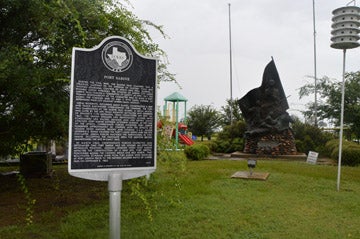The first fort to defend Sabine Pass
Published 5:20 pm Friday, November 18, 2016

- Ft. Sabine was built before the more famous Ft. Griffin to defend Sabine Pass against the Union. After suffering from a shelling from Union ships and disease, the fort was abandoned.
SABINE PASS — Many know about Lt. Dick Dowling and his men at Ft. Griffin and how they staved off a Union flotilla from Sabine Pass during the Civil War.
Many, however, may not know there was a fort prior to Ft. Griffin built to protect Sabine Pass.
Fort Sabine was off Farm Road 3322 and State Highway 87 one mile south of the Sabine Pass Battleground State Historical Park and 15 miles south of Port Arthur in southeastern Jefferson County, according to the The Handbook of Texas Online. Fearing a Union invasion during the Civil War, the citizens of Sabine Pass decided to build a fort to protect their town. Local residents, including many slaves, constructed a dirt and timber earthwork overlooking the Sabine River.
The post was garrisoned by local militia, the Sabine Pass Guard, and later by the Sixth Texas Infantry Battalion.
On September 24, 1862, the fort was shelled by Union gunboats and severely damaged. With the fort’s ability to continue functioning already in doubt, yellow fever broke out among the remaining troops, and Maj. Josephus S. Irvine ordered the guns spiked and the position abandoned.
The following March, Maj. Julius Kellersberg inspected the remains of Fort Sabine and determined that the site was no longer useful. Consequently, he ordered the construction of a new fort, several miles away, which became Fort Griffin.
Fort Griffin was completed in August 1863, when the two 32-pound guns from Fort Sabine were installed and reactivated.
The 2013 state historical marker for Fort Sabine reads:
During the Civil War, the Sabine Pass Channel was a strategic gateway to the interior of eastern Texas and western Louisiana, control of which was vital.
Fearing a possible Union invasion, the citizens of Sabine City (later Sabine Pass) formed a “committee of safety” in April 1861. The primary responsibility of the committee was to build a fort along the channel and to arm it with guns capable of defending their city against Union naval assault.
Local residents, including many slaves, constructed a dirt and timber earthwork overlooking the channel. The fort was garrisoned by the Sabine Pass Guard, a local militia, and later by the 6th Texas Infantry Battalion and members of Spaight’s 11th Battalion, Texas Volunteers.
On Sept. 24, 1862, the Union steamer USS Kensington, along with schooners USS Rachel Seaman and USS Henry Janes attacked. Fort Sabine suffered extensive damage.
At the time of the attack, Confederate forces manning Fort Sabine numbered approximately 60. Coupled with the effects of yellow fever among troops and citizens, C.S.A. major Josephus S. Irvine ordered the Fort’s guns spiked and the site evacuated.
Union forces mastered the earthworks at Fort Sabine, occupying the immediate area for months before abandoning the site in early 1863.
In March 1863, Confederate forces inspected and determined that Fort Sabine was no longer an effective defensive position. Lessons learned from Fort Sabine impacted the construction of a new site, Fort Griffin, positioned along the channel about one mile north.
Two reactivated 32-pound guns from Fort Sabine were installed at Fort Griffin prior to the historic second battle of Sabine Pass on September 8, 1863.
David Ball: 409-721-2427





